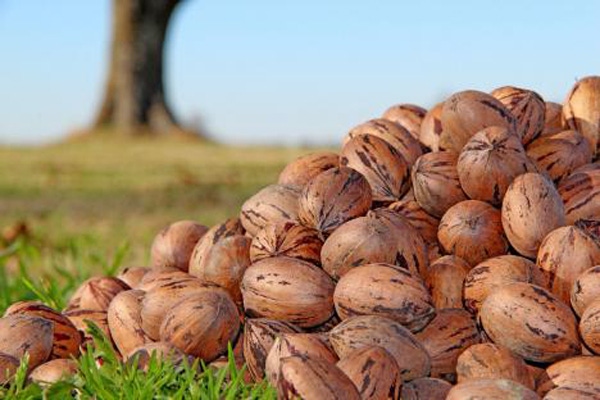September 16, 2015

Leaders in the U.S. pecan industry are bullish about the chances that a federal marketing order could be put into place in time for next year’s harvest and hope it will spawn success akin to that enjoyed by those who grow and sell almonds and pistachios.
“We think we’ve made our case during federal hearings in three cities where 55 (industry members) testified over eight days,” said Mike Adams, president of the American Pecan Board.
Those hearings concluded in late July, and Adams said it is now up to U.S. Secretary of Agriculture Tom Vilsack to weigh the evidence presented at the hearings and decide whether to call for further comment, support the marketing concept and call for a referendum, or reject the proposal.
Adams said the Secretary’s decision is likely to be made this fall.
Adams and others have pointed out the production of pecans and pricing for them has remained fairly stagnant since the 1960s, particularly when compared to growth in the almond sector.
“The California Almond Board has done a great job with the growth of acreage and prices,” said Ben King, who last year became a partner with Brody and Barrett Blain in the largest grower-sheller pecan operation in California - Pacific Gold Agriculture - with offices in Visalia and Colusa.
The company has 300 acres of pecans in Colusa and 550 acres in McFarland.
King believes the marketing order will help the industry remain sustainable by establishing quality standards and spreading the word on the health benefits of pecans.
Adams, a Texas pecan grower, posted an article on the pecan board’s website in which he showed that the nation’s pecan crop has grown very little since 1960 when it was 61 million pounds.
By comparison, the almond crop grew to over 2 billion pounds by 2012, an increase 33 times larger than it was 50 years earlier.
In addition, he says the farm value of almonds grew by a factor of 133 from 1960-2012.
For pecans, meanwhile, the farm value increase was a factor of 10.
He believes the order will bring marketing clout that is particularly needed at this point since recent Chinese demand for the native nut spawned new plantings.
Adams said the order would focus on driving domestic sales to assure growers have a home for pecans as production grows.
The proposed order would authorize data collection, research and promotion activities and grade, size, quality, pack and container regulation.
Those activities would be funded by assessments under the marketing order that would range between one and three cents per pound, depending on the category of nuts. Economic studies have shown that investment would be more than recouped through marketing, Adams said.
The federal marketing order would be voted on by qualified growers and re-approved every five years.
If implemented, the order would be overseen by a council of 17 grower and handler representatives.
One of the challenges for the pecan industry is that it is “spread out geographically,” said Bruce Caris, chief operating officer of grower-sheller Green Valley Pecans in Sahuarita, Ariz.
Caris said that, although there are separate, very effective associations within the various growing regions across the U.S., the proposed marketing system would provide a “communications center” that would be a national voice.
Pecans are grown in 15 states: Alabama, Arkansas, Arizona, California, Florida, Georgia, Kansas, Louisiana, Missouri, Mississippi, North Carolina, New Mexico, Oklahoma, South Carolina and Texas.
The top three producers are Georgia, Texas, and New Mexico.
Adams said there are separate national pecan groups for growers and processors, three regional grower associations, 14 state grower groups, and two state commodity boards.
Caris and Adams agree the order would also help the industry get a better handle on data that includes the number of bearing and non-bearing acres.
Jim Zion, managing partner with Meridian Growers based in Clovis, Calif., said the pecan industry is certain to benefit from generic marketing, particularly given that pecans are commonly seen as an ingredient.
He believes adding pecans grown in Arizona to his company’s portfolio brings benefits that come with diversity.
“We grow almonds, pistachios and pecans,” Zion said. “If pistachios don’t get a home run in a particular year, almonds are sure to get a base hit.”
Zion believes education is a key to getting everyone in the industry to embrace the idea of a marketing order and that growing generic demand for pecans “can set the table for everybody.”
If branded companies want to promote their product, they can build on what has already been established by the order.
“They can take that and say, “Here’s why you want to buy ours,” said Zion.
John Heuler, a board member for A&P Ranch, which grows pistachios and pecans in Arizona and almonds and pistachios in California, finds it “baffling” that there is not already a federal marketing order for pecans.
“Pecans have an excellent upside,” he said. “There are not a lot being produced, and they are being exported now. They have the best story to tell as the only nut indigenous to the United States. It’s silly to have such a great product and not tell anybody about it.”
When the pecan industry began more than 100 years ago, he says there was not a focus on being an international business as has been the case in almonds and pistachio. This has changed.
He pointed out that about $14 million is spent on pistachio marketing while the amount spent on marketing pecans is well under $1 million a year.
Heuler said one of the challenges is that the relationship between growers and shellers is often adversarial.
“Cooperation and marketing are necessary,” he said. “If you market together and promote together in a joint coordinated effort, you have success.”
About the Author(s)
You May Also Like




